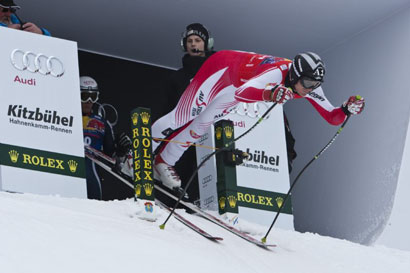
Michael Walchhofer (AUT) came in 1st in the second Downhill Training Photo by: Rolex / Daniel Forster
. world ski news : Walchhofer sets fastest time in opening training run at Hahnenkamm-Race - 22 ßíóàðè 2009 - 12:38
Kitzbuehel is top for prize money
Austrian Michael Walchhofer was not put off by the ever changing visibility as the fog moved in and out of the mid section of the Hahnenkamm course to set today’s fastest training run time. Walchhofer, who paid tribute to the course crew as the course was not as bumpy as last year, was the only racer to break the two minute barrier: “It was a great run, it was great to ski, the course crew have done perfect work on the slope. It is icy but not as bumpy as last year. It is very important to take all of the speed out of the turns,” explained Walchhofer.

Michael Walchhofer (AUT) came in 1st in the second Downhill Training Photo by: Rolex / Daniel Forster
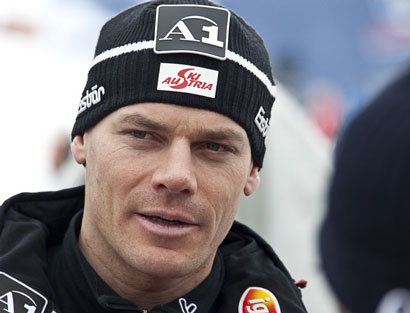
Michael Walchhofer had the fastest time in the second Downhill Training Photo by: Rolex / Stephan Cooper
With the training run continually stalling the first run for long periods, Rolex Testimonee Hermann Maier gave his fans lots to hope for as he came down in 5th place behind Walchhofer, who was followed respectively by Didier Cuche (SUI) in 2nd, and Christoph Gruber (AUT) and Bode Miller (USA) in 3rd Equal. Maier was happy with his placing, yet would have preferred to have been closer in time to the leader: “For sure I am happy, maybe the time [difference] is a little big but the position is great.” Asked whether the fog had hindered his run at all, Maier felt that snow had become a little wet but that he felt ok, “it is better to have the fog in this section,” commented Maier, “than at the finish.”
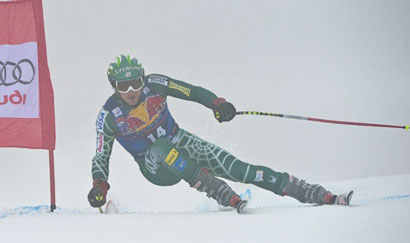
Bode Miller, in the second Downhill Training, finished 3rd Equal Photo by: Rolex / Kurt Arrigo
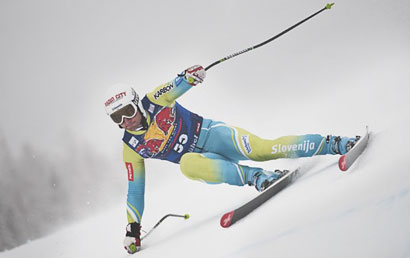
Alek Glebov (SLO), second Downhill Training Photo by: Rolex / Kurt Arrigo
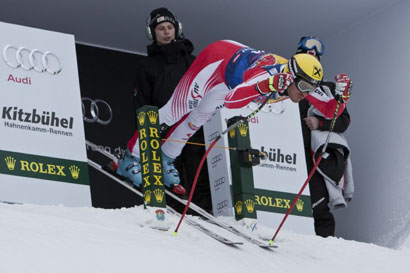
Hermann Maier (AUT) finished 5th in the second Downhill Training Photo by: Rolex / Daniel Forster
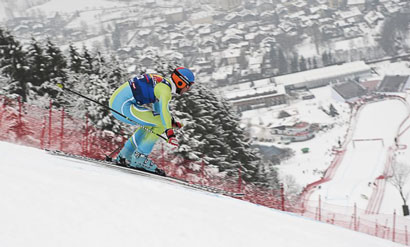
Andrej Jerman (SLO), second Downhill Training Photo by: Rolex / Kurt Arrigo
Both Maier and Walchhofer spoke positively about the new start fascia and the Rolex speedometer on the finish screen. Speaking of the start, Maier felt that the new look was very clean and exciting for the crowd. Walchhofer agreed that it was great that the spectators could see how fast the racers were going as they approached the finish. Walchhofer holds the fastest speed down the Zielschuss, 153kmh, though he would like to better his speed from Wengen, 156kmh.
With a second training run scheduled for Thursday, this was a chance for the experienced racers to become reacquainted with the Streif and for the debutants to address their nerves and fears.
Last stop before departure: Restaurant Hochkitzbuehel
Once the inspection has been done and the course has been studied, there is the ride on the Hahnenkammbahn up to the top. The Streif is not for the feint of heart and at least the gladiators that do battle with their demons before launching themselves out of the start gate have the safe haven of the Restaurant Hochkitzbuehel in which to gather their thoughts before their run. The 550-seat restaurant sits at the summit of the Gondola lift that brings racers, fans and skiers alike up to the very top of the Streif.
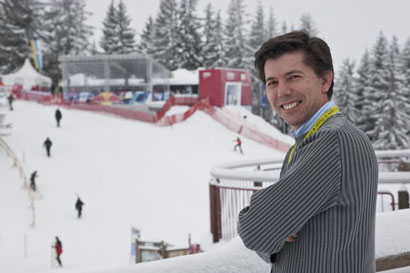
Maksimovic Vojislav, the owner of the Hochkitzbuehel restaurant Photo by: Rolex / Daniel Forster
The view from the Restaurant catches the course from the start down to the beginning of the Mausefalle. This is one of the most dramatic few seconds in alpine ski racing and it is no wonder that the racers need time to compose themselves: 0 to 80kmh in just a matter of seconds. The walk from the restaurant to the start has been compared to a walk to the gallows. It takes a brave soul to stand at the top of the course and look out over the start, yet it is in the restaurant that one can see the mental preparation and courage on the faces of the racers.
This year, Vojislav Maksimovic has taken on the General Manager's job. In his opinion this is the best job in the Restaurant world. He first came to Kitzbuehel to watch the race as a fifteen year old and was memorised by the downhill: “Everything revolves around The Race,” he explains, with a huge animated smile. “The fact that prominent politicians, celebrities, sportsmen and people from all walks of life come to the race is really exciting. I am very happy to have this job.”
When the racers enter the restaurant, it is time for them to get serious: Each team has their own room where the racers relive the course, focusing and visualising each turn, each jump, attempting to live the perfect run in their minds. According to Maksimovic, the silence is incredible. While the public are able to use the restaurant, they are asked to be respectful of the competitors and the majority adhere. For many of the fans, just seeing their heroes in the flesh is enough. While the public are not allowed to go inside the team rooms, as the racers come out and head off to the start many of the competitors connect with their fans to sign autographs and pose for a few pictures.
Many mountain restaurants, like the Restaurant Hochkitzbuehel, prominently display signs requesting visitors not to bring their own food. Although in this case there is an exception: the highly tuned athletes that participate in the Hahnenkamm are the only people allowed to picnic in Maksimovic's restaurant. “They bring their own isotonic drinks and eat muesli bars. They do come back later and party and celebrate but this is their time,” he explains.
The Hochkitzbuehel is open all year round and many visitors come up to the restaurant in the summer to experience the start hut. Many like to see just how steep it really is looking out of the start. Didier Cuche won the Downhill here in Kitzbuehel last year and legend has it that there is an area of the grass just below the start that has died away. Visitors are now told that this was the piece of grass on which Cuche spat just before leaving the start on his victorious run!
While the likes of Rolex Testimonee Hermann Maier, Benni Raich and slalom star Reini Herbst all frequent the restaurant on race day, others like Bode Miller do their final preparations in other places. Each racer has his own routine before talking the short walk up to the start to meet their date with destiny. Once they have broken the wand and left the start there is about two minutes of high octane excitement as they head quickly down to Kitzbuehel, leaving the peace and tranquillity of the Restaurant Hochkitzbuehel far behind.
January 21, 2009
www.hahnenkammnews.com
Hahnenkamm-Race
Kitzbuehel, Austria
January 23 - 25, 2009
A victory in Kitzbuehel is worth it in many ways.
In the whole World Cup the winners of the Hahnenkamm Races are the most highly rewarded. In 2009 there will be more than 550,000 EUR in the Hahnenkamm prize-money pot.
Long gone are the times, when non-cash prizes were awarded at the Hahnenkamm Race. In 1955 radios, electric shavers and watches given by sponsors were among the awards. In addition to these non-cash prizes the Tyrolean government subsidized the Races with 5000 Austrian Schillings. It was not until 40 years later, in 1992, that prize money was paid in the form of gold coins.
Today the athletes in the top 30 share an amount of 550,000 EUR. For the Super-G a total of 130,000 EUR is awarded, in both the Downhill and the Slalom 175,000 EUR will be awarded and the prize money for the Hahnenkamm Combination amounts to 70,000 EUR. The winner of the Downhill leaves Kitzbuehel with 70,000 EUR. This is the highest amount of prize money in the World Cup, also for the individual disciplines. “This distribution scheme has been used for three years now. It shows that we appreciate the performance of many athletes, even those who do not manage to score a top ranking,” explains Michael Huber, chairman of the Organizing Committee.
Official information provided by the Kitzbueheler Ski Club (K.S.C.)
January 21, 2009
www.hahnenkammnews.com
Hahnenkamm-Race
Kitzbuehel, Austria
January 23 - 25, 2009